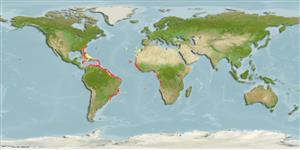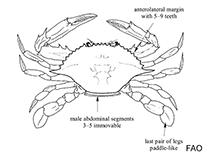Callinectes marginatus (Milne-Edwards, 1861)
Marbled swimcrab| Native range | All suitable habitat | Point map | Year 2050 |

|
| This map was computer-generated and has not yet been reviewed. |
| Callinectes marginatus AquaMaps Data sources: GBIF OBIS |
Upload your photos
Google image | No image available for this species;
drawing shows typical species in Portunidae.
Google image | No image available for this species;
drawing shows typical species in Portunidae.
Classification / Names Common names | Synonyms | CoL | ITIS | WoRMS
Malacostraca | Decapoda | Portunidae
Environment: milieu / climate zone / depth range / distribution range Ecology
Benthopelagic; brackish; depth range 1 - 421 m (Ref. 105052). Tropical; 35°N - 31°S, 82°W - 14°E
Distribution Countries | FAO areas | Ecosystems | Occurrences | Introductions
Atlantic Ocean: from southeastern Florida to Brazil rarely in Bermuda and North Carolina, also in the Cape Verde Islands and along the African coast from Mauritania to Angola.
Length at first maturity / Size / Weight / Age
Maturity: Lm ? range ? - ? cm Max length : 10.0 cm CW male/unsexed; (Ref. 417)
In shallow littoral environments, typically from intertidal pools to 3 m (Ref. 105199). Inhabits shallow salt water on sandy or sandy mud bottom (Ref. 435) in brackish waters of estuaries (Ref. 417). Also found on algae and grass flats, sandy beaches, rocky pools, eroded coral bases (Ref. 105199), coral reef (Ref. 121879), oyster bars (Ref. 105199), and edge of mangroves (Refs. 105199, 121880). Rarely found in the open sea, from the intertidal to depth of 25 m (Ref. 121880). Associated with the barnacle Chelonibia sp. (Ref. 105200). In general, portunids are opportunistic omnivores with preference for animal prey (Ref. 100840).
Life cycle and mating behavior Maturity | Reproduction | Spawning | Eggs | Fecundity | Larvae
Members of the order Decapoda are mostly gonochoric. Mating behavior: Precopulatory courtship ritual is common (through olfactory and tactile cues); usually indirect sperm transfer.
Main reference
References | Coordinator | Collaborators
Fischer, W., G. Bianchi and W.B. Scott (eds.). 1981. (Ref. 435)
IUCN Red List Status (Ref. 130435)
CITES status (Ref. 108899)
Not Evaluated
CMS (Ref. 116361)
Not Evaluated
Threat to humans
Human uses
Fisheries: commercial
| FishSource |
Tools
More information
Internet sources
BHL | BOLD Systems | CISTI | DiscoverLife | FAO(Publication : search) | Fishipedia | GenBank (genome, nucleotide) | GloBI | Gomexsi | Google Books | Google Scholar | Google | PubMed | Tree of Life | Wikipedia (Go, Search) | Zoological Record
Estimates based on models
Preferred temperature
(Ref. 115969): 14.1 - 24.4, mean 17.5 (based on 89 cells).



